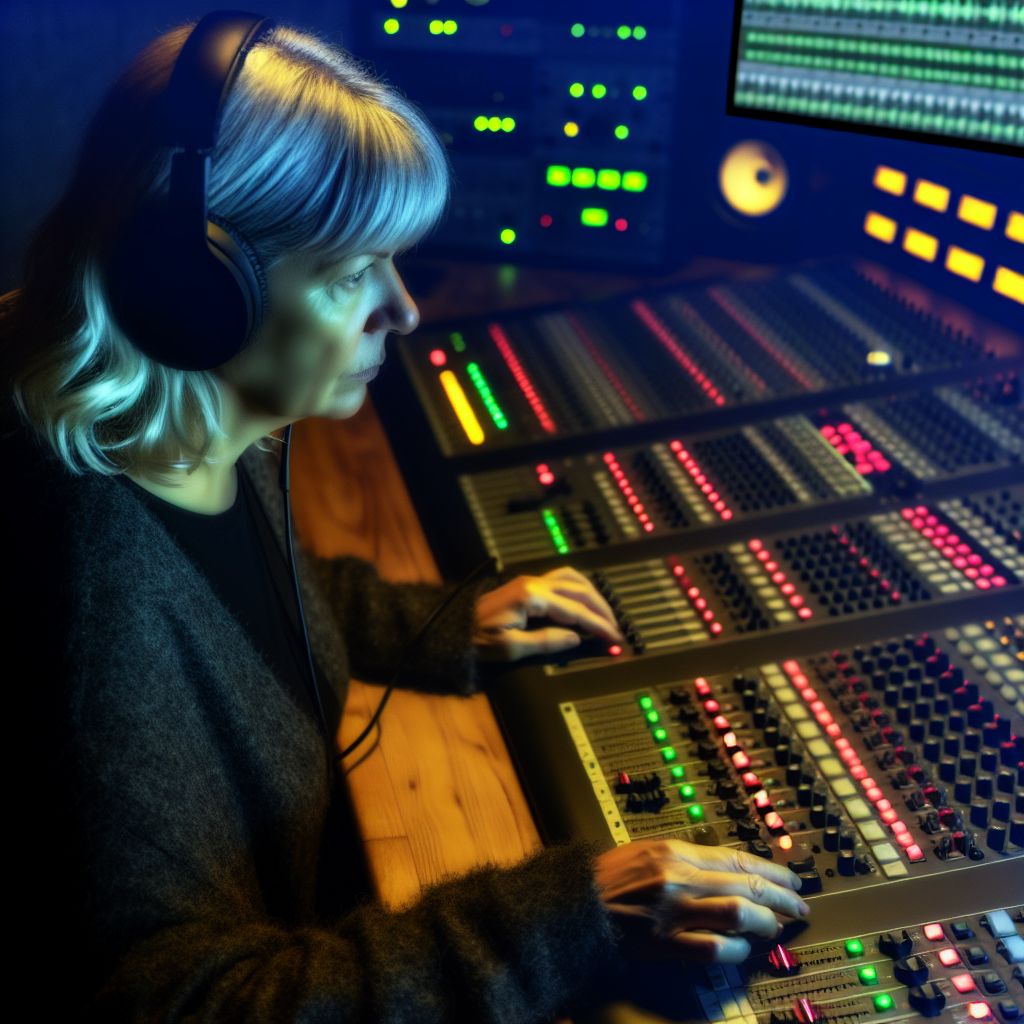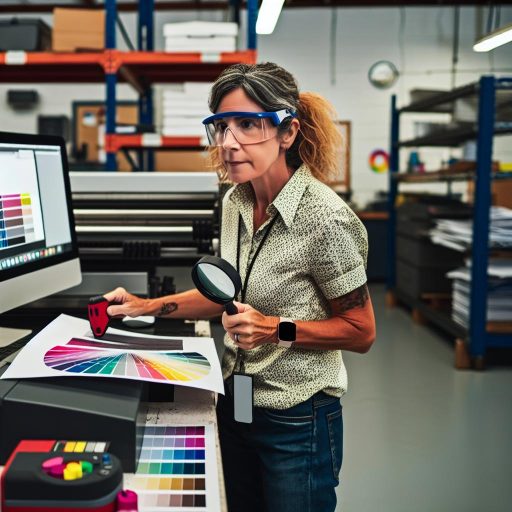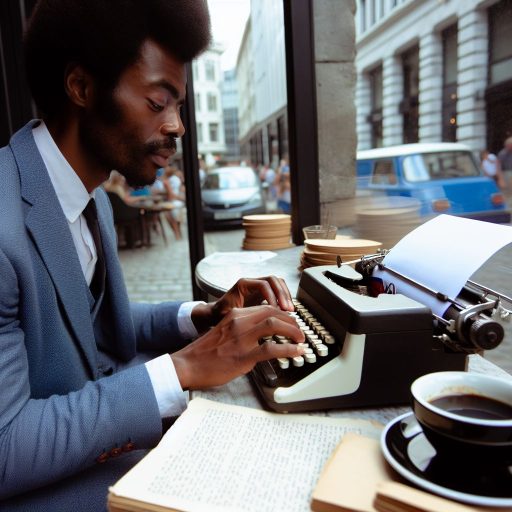Introduction
Soundscapes play a crucial role in shaping the emotional landscape of a film.
They set the mood, enhance the story, and create a sense of place.
By carefully layering sounds, filmmakers can immerse viewers in their cinematic world.
A soundscape refers to the acoustic environment of a scene.
It includes dialogues, sound effects, ambience, and music.
Together, these elements form an audio backdrop that enhances the overall viewing experience.
Sound can significantly elevate a film’s impact.
It guides viewers’ emotions, drawing them into the narrative.
For example, a suspenseful score can heighten tension in a thriller.
Conversely, a soft melody might evoke nostalgia in a romantic scene.
Building Immersive Soundscapes
Creating effective soundscapes involves meticulous planning and execution.
Filmmakers should start by identifying the film’s tone and theme.
Once they establish this foundation, they can select appropriate sounds that reflect the story’s essence.
Layering different sounds adds depth and richness to the auditory experience.
Background sounds help create context, while foreground sounds direct the audience’s attention.
For example, busy city noise can enhance a street scene, making it feel alive.
The Role of Ambience
Ambience is vital in crafting a believable soundscape.
Natural sounds, like birds chirping or wind rustling, bring authenticity to settings.
Selecting location-specific sounds ensures the film accurately represents its environment.
Music also plays a central role in soundscapes.
Transform Your Career Today
Unlock a personalized career strategy that drives real results. Get tailored advice and a roadmap designed just for you.
Start NowIt shapes the emotional tone of scenes, guiding audience reactions.
Filmmakers must choose scores that align with their vision while considering the pacing of the narrative.
Soundscapes Enhance Storytelling
In summary, soundscapes enrich the storytelling experience in films.
By combining dialogues, sound effects, ambience, and music, filmmakers create a captivating audio world.
This audio landscape engages viewers, making the film unforgettable.
Sound plays a vital role in filmmaking.
It shapes the viewer’s experience and influences their emotions deeply.
A film without sound is often a flat experience.
The right sound can elevate a scene, transforming it from ordinary to extraordinary.
This section explores how sound creates atmosphere, builds emotion, and subtly influences audience perception.
Importance of Sound in Creating Atmosphere and Emotion
Sound is more than just a backdrop in films.
It acts as an emotional guide.
The right sound design immerses the audience into the film’s world.
Here are some key ways sound contributes to atmosphere and emotion:
- Establishes Setting: Sound conveys the time and place of a film. A bustling city’s noise or a serene forest sounds distinct and clearly defines locations.
- Evokes Emotion: Music swells and dips, evoking feelings. A sudden drop in sound can create tension, while uplifting music induces joy.
- Enhances Narrative: Sound adds layers to storytelling. A character’s footsteps can signify their mental state or foreshadow events.
- Creates Connection: Familiar sounds can resonate with audiences. They evoke memories and emotions, fostering a deeper connection to the film.
Overall, sound is crucial for engaging viewers on an emotional level.
It frames the narrative while enhancing the visual storytelling.
Effective sound design ensures viewers not only see but also feel the film’s essence.
Different Types of Sounds Used in Films
Filmmakers use various types of sounds to create engaging soundscapes.
Each type serves unique purposes in storytelling.
Showcase Your Business Today
Reach thousands of readers actively exploring professional services. Publish your business profile and grow your audience now.
Publish NowThe main categories of sound include:
1. Dialogue
Dialogue is pivotal in films.
It conveys character intentions, motivations, and plot developments.
Clear and effective dialogue keeps the audience engaged.
In film, dialogue can:
- Advance the plot
- Reveal character relationships
- Enhance emotional depth
2. Music
Music is another powerful tool in driving emotions.
Composers craft scores that resonate with viewers.
Music can create tension, excitement, or nostalgia.
Key roles of music include:
- Setting the mood
- Building suspense
- Providing cultural context
3. Ambient Noise
Ambient noise comprises the background sounds of a scene.
These sounds create a sense of realism and place.
Whether the gentle rustle of trees or city traffic, ambient noise adds depth.
Key features of ambient noise are:
- Enhancing realism
- Contributing to atmosphere
- Creating a sense of space
4. Sound Effects
Sound effects are critical in illustrating action.
They draw attention to on-screen activities.
Sound effects can range from dramatic explosions to subtle creaks.
Their benefits include:
- Supporting visual cues
- Engaging the audience
- Enhancing realism
How Sound Can Subconsciously Influence the Audience
Sound acts on audiences not just consciously but also subconsciously.
Filmmakers can manipulate sound to evoke specific responses.
Here’s how sound affects audiences without their realization:
1. Psychological Impact
Certain sounds create psychological effects.
A sudden loud noise can startle viewers, heightening emotion.
Similarly, calming melodies may relax audiences.
This dual nature makes sound a powerful emotional trigger.
2. Memory Associations
Sound can evoke memories.
Familiar tunes from childhood can transport viewers back in time.
When a recognizable piece plays, it stirs emotions and memories linked to it.
3. Atmosphere Building
Sounds blend together to craft immersive environments.
A scene filled with suspense can use low-frequency rumbles.
These sounds create anticipation and keep viewers on edge.
4. Audience Engagement
Sound design encourages active participation from the audience.
Viewers often react instinctively to audio cues, even when unaware.
When combined with visuals, sound shapes the overall experience.
Key Takeaways
Understanding the role of sound in films is essential for filmmakers.
Sound creates atmosphere, conveys emotion, and enhances viewer engagement.
Various types of sounds work together to build an effective soundscape.
Recognizing how sound influences audiences subconsciously is equally important.
The best sound design engages audiences, shaping their experience and deepening their connection to the film.
Sound is a powerful storytelling element.
It complements visuals by enhancing emotion and atmosphere.
Showcase Your Business Today
Reach thousands of readers actively exploring professional services. Publish your business profile and grow your audience now.
Publish NowEffective soundscapes create immersive environments that resonate with viewers.
A well-crafted sound design does not just accompany the film; it elevates the entire cinematic experience.
Filmmakers should remember that with sound, they have the power to connect with their audience on a profound level.
In the art of filmmaking, sound design plays an essential role in creating an immersive experience.
Effective soundscapes enhance the storytelling, establish mood, and convey emotions.
Different elements contribute to successful sound design.
Understanding these elements can elevate the quality of a film’s auditory experience.
Creating a Balance Between Sound Elements
Sound design is a multifaceted discipline that requires careful consideration of various sound elements.
Achieving balance is crucial for creating an engaging soundscape.
Here are key components to consider:
- Dialogue: The primary vehicle for storytelling in films. It should be clear and positioned correctly within the sound mix.
- Sound Effects: These add realism and depth. They can range from subtle background noises to prominent action sounds.
- Music: A powerful emotional tool that enhances scenes. It can dictate the film’s atmosphere and pace.
- Ambience: It encompasses background sounds that create context. Ambience helps ground the audience in the film’s world.
- Foley: These are custom sound effects created by artists. Foley adds authenticity to everyday sounds, making them more relatable.
Striking a balance involves adjusting levels and spatial placement of these elements.
Each component of sound contributes to the overall experience.
Too much of one element can overwhelm the others, leading to confusion.
Conversely, too little can cause scenes to feel empty or uninspired.
Filmmakers must carefully listen and refine the mix.
Using Sound to Support the Narrative and Enhance Storytelling
Sound serves as a robust narrative device in film.
It strengthens the connection between the audience and the story.
Here are ways sound can support the narrative:
- Character Themes: Assigning specific musical motifs to characters enhances their emotional journeys. Recognizable themes create continuity and depth.
- Sound Cues: Auditory signals can foreshadow events. For example, ominous music can hint at impending danger.
- Emotional Resonance: Music invokes feelings, guiding audience reactions. A poignant score heightens emotional scenes and drives empathy.
- Location Indicators: Unique sounds define settings. For example, city noises establish an urban feel while birds in the background convey tranquility.
- Flashbacks and Dreams: Altering sound design can signal transitions. Changes in audio cue viewers to shifts in time or reality.
Using sound effectively enhances the narrative flow.
The audience remains engaged when they hear sounds that resonate with the story.
Sound transitions can also play a significant role, blending scenes and keeping the audience invested.
Importance of Sound Editing and Mixing
Sound editing and mixing are pivotal in the post-production process.
These stages refine and polish the film’s auditory experience.
Each contributes uniquely to the overall sound design:
Sound Editing
Sound editing involves assembling all the audio elements into a coherent whole.
Here’s what an effective sound editing process entails:
- Data Organization: Organizing audio files and assets allows for efficient access during editing.
- Dialogue Editing: Ensuring clarity and continuity in dialogue is critical. Removing interruptions and unwanted noises enhances quality.
- Integrating Sound Effects: Editorially introducing sound effects at the right moments creates realism. The placement needs to match visual cues for authenticity.
- Ambience Layering: Layering ambient sounds deepens the experience. Adding subtle background noises enhances the sense of place.
- Syncing Sounds with Visuals: Perfect synchronization ensures the sound feels cohesive with the imagery. It makes actions feel natural and believable.
Sound Mixing
Sound Mixing
Mixing is the process of adjusting sound levels and spatial positioning.
Effective mixing is crucial for a balanced soundscape.
Here’s what sound mixing involves:
- Level Balancing: Adjusting the volume of each sound element is necessary. Dialogue, effects, and music should coexist harmoniously.
- Frequency Management: Managing different frequency ranges prevents sounds from clashing. This clarity ensures the audience perceives each sound distinctly.
- Spatialization: Placing sounds in a three-dimensional space immerses viewers. Techniques like panning give directionality to sound, creating depth.
- Dynamic Range Control: Proper control of dynamic range maintains the film’s emotional impact. Peaks and troughs must feel natural without overwhelming the listener.
- Final Review: A final mix should undergo careful listening across different playback systems. This testing ensures consistency everywhere the film is shown.
Ultimately, a well-executed sound editing and mixing process enhances audience immersion.
It transforms auditory experiences from ordinary to extraordinary.
Creating effective soundscapes for films relies on understanding and mastering various sound design elements.
By balancing sound components, supporting the narrative, and emphasizing the importance of editing and mixing, filmmakers can craft rich auditory worlds.
These soundscapes invite audiences into unique experiences that resonate long after the credits roll.
Gain More Insights: Navigating Ethical Dilemmas in News Anchoring
Foley Sound Effects
Foley sound effects play a crucial role in film soundscapes.
They add reality and depth to scenes.
These sounds must blend seamlessly with dialogue and music.
Foley artists recreate everyday sounds, enhancing the viewer’s experience.
Showcase Your Business Today
Reach thousands of readers actively exploring professional services. Publish your business profile and grow your audience now.
Publish NowHere are some techniques for effective Foley creation:
- Observation: Watch the scene closely.
- Recording Natural Sounds: Capture sounds by using everyday objects.
- Microphone Placement: Use high-quality microphones.
- Layering Sounds: Combine multiple recordings.
- Editing: Use sound editing software.
Ambient Noise and Background Music
Ambient noise provides a sense of space and location.
It immerses the audience in the film’s environment.
Background music sets the emotional tone for scenes.
Both elements enhance storytelling significantly.
To create effective ambient soundscapes, consider these approaches:
- Realistic Ambiance: Record natural sounds in real environments.
- Textured Layers: Layer different sounds to form a rich backdrop.
- Dynamic Volume Control: Adjust volume based on scene dynamics.
- Emotionally Charged Music: Select music that complements the scene’s mood.
- Cue Music Changes: Coordinate music transitions with scene changes.
Sound Effects and Sound Design
Sound effects bring vibrancy and excitement to films.
They can dramatically enhance action scenes.
Effective sound design creates an intricate tapestry of auditory experiences.
Utilize these techniques for precise sound design:
- Storytelling through Sound: Use sound to advance the story.
- Unique Sound Creation: Create original sounds for specific needs.
- Framework Building: Structure sounds to develop a coherent auditory environment.
- Creating Doppler Effects: Mimic real-life movement.
- Balance and Clarity: Ensure that important sounds are clear.
Integration of Soundscapes
Integrating all sound elements is vital for cohesion.
The soundscape should support visual storytelling.
Each component must complement one another effectively.
Here are considerations for effective integration:
- Consistency Across Scenes: Maintain sound quality and style throughout.
- Dialogue Clarity: Prioritize clarity in dialogues.
- Sound Panning: Use stereo panning to create spatial dimensions.
- Testing & Feedback: Test the soundscape in various settings.
- Final Mix: Perform a final mix of all elements.
Crafting Immersive Sound Experiences
Creating effective soundscapes requires creativity and attention to detail.
Each technique contributes uniquely to the overall experience.
Use Foley sound, ambient noise, and sound design to craft immersive environments.
The soundscape is a vital part of storytelling in film.
Master these techniques to elevate your film’s audio landscape.
Gain More Insights: How to Sell Your Screenplay: From Query to Deal
Importance of Collaboration in Sound Design
Creating effective soundscapes requires much more than technical skills.
Collaboration plays a critical role in enhancing the sound design process.
It involves working closely with various team members involved in the production.
This teamwork helps in crafting a cohesive sound environment.
Without collaboration, sound designers might miss essential elements that contribute to storytelling.
Working Closely with Directors and Cinematographers
The relationship between sound designers, directors, and cinematographers is pivotal.
Directors possess a vision that outlines the film’s emotional tone.
Listening to their insights helps sound designers align their work with the film’s narrative.
Here are some key aspects of this collaboration:
- Define the Film’s Emotion: Directors articulate the intended emotions for each scene. This clarity guides the sound choices.
- Discuss Key Themes: Exploring the film’s themes allows sound designers to embed relevant auditory cues. This adds depth to the storyline.
- Share Visual Concepts: Cinematographers create visual storytelling through lighting and framing. Sound designers can enhance these elements through complementary audio effects.
- Practical Adjustments: On set, adjustments occur based on various factors. Flexibility and open dialogue lead to better sound outcomes.
- Feedback Loop: Constant feedback during pre-production and post-production strengthens the final sound design. This iterative process refines audio elements efficiently.
By focusing on these aspects, sound designers can fulfill the director’s vision.
Each meeting builds a stronger understanding of sound needs and expectations.
Communicating with Sound Engineers and Editors
Sound engineers and editors are essential partners in sound design.
Their expertise complements the artistic choices made by the sound designer.
Effective communication between these roles can significantly enhance the final film.
Here’s how to foster that communication:
- Clarify Technical Needs: Sound designers should clearly outline their requirements. This includes specifications for equipment and software.
- Frequent Updates: Regular updates regarding progress keep everyone informed. Whether it’s check-ins or demo sessions, consistency is key.
- Handling Challenges: When technical issues arise, addressing them as a team fosters collaboration. Problem-solving together can lead to innovative solutions.
- Integration of Sounds: Sound engineers work on integrating sound effects and dialogue. Sound designers should collaborate closely during this phase to ensure cohesive layering.
- Final Mix Sessions: Engaging in final mix sessions allows sound designers to guide their vision. Participation in these sessions creates a platform for last-minute adjustments.
Through these collaborative efforts, the sound design process can transcend individual contributions.
Instead, the film achieves a higher level of auditory experience.
How Collaboration Can Elevate the Final Product
Collaboration serves to elevate the final product in numerous ways.
When creators from different disciplines come together, they share unique perspectives.
This melding of ideas can lead to innovative sound solutions.
Showcase Your Business Today
Reach thousands of readers actively exploring professional services. Publish your business profile and grow your audience now.
Publish NowHere are some benefits of collaboration in sound design:
- Enhanced Creativity: Diverse perspectives foster creativity. Collaborating allows sound designers to explore styles beyond their personal preferences.
- Improved Problem-Solving: Different team members bring varied skills. Working together allows for creative problem-solving strategies.
- More Robust Soundscapes: Collective brainstorming results in richer soundscapes. Depth and richness are achieved through various auditory elements.
- Shared Ownership: Collaboration builds a sense of shared investment in the project. Each team member feels connected to the final output.
- Defined Roles: Clear communication helps define roles within the team. Knowing who is responsible for what improves workflow and efficiency.
Collaboration amplifies the impact sound design has within a film.
By pooling resources and sharing knowledge, the final product benefits immensely.
Each sound designer should prioritize collaboration as an integral component of their creative process.
Collaboration builds a bridge between vision and execution.
By connecting with directors, cinematographers, sound engineers, and editors, the sound design process can flourish.
Creating a strong network encourages creativity and innovation.
This leads to the creation of powerful and immersive soundscapes that resonate with audiences.
Collaboration isn’t just a bonus; it’s essential for successful sound design.
It enables filmmakers to craft soundscapes that transport audiences into the narrative.
Only through teamwork can sound artists fully realize their creative potential and contribute to cinema in meaningful ways.
Learn More: Building Long-Lasting Media Relationships as a Publicist

Creating effective soundscapes in film is an art.
This section will explore notable case studies of sound design in successful films.
By examining specific examples, we will uncover how sound shapes the viewing experience and the lessons we can take away.
Examples of Films with Memorable Sound Design
- Gravity (2013)
- Dunkirk (2017)
- Blade Runner 2049 (2017)
Gravity
Alfonso Cuaron’s “Gravity” utilizes sound in groundbreaking ways.
The film presents a unique environment: space.
In this vacuum, sound operates differently than on Earth.
The absence of air means no direct sound transmission.
Thus, Cuaron and sound designer Skip Lievsay make bold choices.
The film’s dramatic score, composed by Steven Price, enhances emotional weight.
For example, the crescendo during the destruction of the space shuttle heightens tension.
Viewers feel fear as chaos unfolds, drawing them into the experience.
Furthermore, Lievsay uses sound to emphasize isolation.
Moments where silence prevails evoke a sense of vulnerability.
With no ambient sound, the audience feels the weight of solitude in space.
This choice conveys the main character’s emotional state effectively.
Additionally, the use of diegetic and non-diegetic sounds creates layers of immersion.
Sounds from floating debris, alarms, and voice communications amalgamate into a tense atmosphere.
This multi-dimensional approach envelops viewers, making them part of the journey.
Dunkirk
Christopher Nolan’s “Dunkirk” showcases an innovative audio experience.
Sound in this film drives the narrative.
Nolan’s integration of sound with visuals enhances tension and urgency.
He employs a ticking clock motif to create a sense of time pressure.
This constant, repetitive sound builds unease throughout the film.
The film features three timelines: land, sea, and air.
Each timeline has unique sound elements that distinguish them.
On land, soldiers’ anxious conversations pierce the air.
On the sea, the sound of waves and ship engines heightens the struggle for survival.
In the air, planes roar overhead, intensifying the urgency of war.
Showcase Your Business Today
Reach thousands of readers actively exploring professional services. Publish your business profile and grow your audience now.
Publish NowMoreover, sound designer Richard King blends realistic war sounds with a haunting score.
The score, composed by Hans Zimmer, accentuates feelings of dread.
As bombers approach, the audience feels their impact.
Layered sound design immerses the audience, making them feel the chaos of war.
Blade Runner 2049
Denis Villeneuve’s “Blade Runner 2049” successfully marries visuals with sound.
The film captures a dystopian future with its rich soundscape.
Sound designer Mark Muncy intricately crafts each auditory experience.
Ambient sounds envelop the viewer, making them feel the weight of the world.
One hallmark feature is the film’s use of music.
The score, created by Hans Zimmer and Benjamin Wallfisch, echoes the original “Blade Runner.”
This continuity connects the two films.
The haunting synths evoke nostalgia while grounding the viewer in the futuristic setting.
Furthermore, the sounds of the city play a crucial role.
The constant hum of vehicles creates a sense of life.
This juxtaposition increases the character’s isolation.
Moments of silence become poignant as they contrast with chaotic audio from the world.
Additionally, diegetic sound enhances the narrative.
Footsteps on wet pavement, distant sirens, and faint conversations bring realism.
These details support the film’s themes of loneliness and existential dread.
The immersive soundscape adds to the visual storytelling, creating a fully realized world.
Analysis of How Sound was Used to Enhance the Viewing Experience
Each of these films utilizes sound to achieve specific objectives.
“Gravity” immerses viewers in a unique environment through silence and targeted sound.
It employs emotional crescendos to communicate vulnerability and tension.
“Dunkirk” uses sound as a narrative device.
The ticking clock enhances the sense of urgency inherent in the story.
The interplay of music and diegetic sound creates a relentless pace, sucking the audience into the action.
In “Blade Runner 2049,” sound creates a sense of place and atmosphere.
The sound design works hand in hand with visuals.
It evokes emotions and enhances immersion in the film’s rich yet desolate world.
Lessons that Can Be Learned from These Examples
- Understand the environment: A film’s setting influences sound design. Create auditory cues that represent the world.
- Use silence effectively: Silence can amplify tension. It forces viewers to engage with the emotional stakes.
- Blend diegetic and non-diegetic sounds: Merging these sound types enriches the auditory experience. It creates depth and realism.
- Cohesive auditory themes: Establish recurrent sound motifs. This technique reinforces emotional connections and enhances storytelling.
- Collaborate with skilled composers: A powerful score can elevate the audience’s experience. Work closely with musicians to achieve desired effects.
Creating effective soundscapes in film requires thoughtful choices.
As these case studies reveal, sound influences how we perceive storytelling.
In mastering sound design, filmmakers can enhance emotional resonance and captivate audiences.
These lessons serve as a valuable guide for aspiring filmmakers looking to create memorable soundscapes.
Discover More: The Role of Brand Managers in Sustainability Initiatives
Creating an effective soundscape for films requires a robust arsenal of tools and software.
In this section, we will explore popular software, the necessity of quality equipment, and offer tips for beginners eager to dive into sound design.
Popular Software for Sound Design
Several software options stand out for sound design in filmmaking.
Below is a list of some of the most widely used software:
- Pro Tools: This industry standard offers powerful editing and mixing capabilities. Its versatility accommodates various sound design tasks, from voiceovers to complex musical scoring.
- Logic Pro: Ideal for macOS users, Logic Pro boasts impressive virtual instruments and effects. Its user-friendly interface simplifies the process for newcomers while still providing deep functionality for professionals.
- Adobe Audition: This software integrates seamlessly with the Adobe Creative Suite. It offers intuitive tools for audio editing, noise reduction, and multi-track mixing, making it a top choice for many filmmakers.
- Reaper: Known for its affordability and flexibility, Reaper serves as a complete digital audio workstation. Its customizable interface attracts independent filmmakers and hobbyists.
- Ableton Live: Musicians and sound designers alike appreciate Ableton Live. Its unique session view allows for spontaneous compositions and intricate live performances.
- Soundtrap: This online audio workstation shines in collaboration. Its cloud-based nature allows multiple users to work on projects simultaneously, making it a great choice for team efforts.
Each of these options provides unique features suitable for various projects.
Choosing the right software depends on your specific needs and workflow preferences.
Showcase Your Business Today
Reach thousands of readers actively exploring professional services. Publish your business profile and grow your audience now.
Publish NowInvesting in Quality Equipment
The quality of your sound greatly relies on your recording equipment.
Investing in quality tools pays off in producing professional-grade soundscapes.
Here are some essential pieces of equipment every sound designer should consider:
- Microphones: A good microphone captures sound accurately. Consider condenser microphones for studio recordings and dynamic microphones for live environments.
- Audio Interfaces: An audio interface improves sound quality and reduces latency. Look for interfaces with multiple inputs and outputs to accommodate complex setups.
- Headphones: Invest in closed-back headphones for monitoring sound without interference. Look for headphones that provide accurate sound reproduction.
- Field Recorders: Portable recorders allow you to capture high-quality audio in various environments. These devices are invaluable for capturing natural sound effects.
- Studio Monitors: Quality monitors provide a flat frequency response, allowing you to hear your mixes accurately. This equipment is crucial for the mixing and mastering stages of sound design.
Quality equipment helps you achieve a professional sound.
Ensure you research and choose tools suited to your specific projects.
Tips for Beginners in Sound Design
Starting in sound design can be daunting, but several tips can simplify your entry into this creative field.
Below is a list of practical advice for beginners:
- Start Small: Begin with simple projects. Focus on creating soundscapes for short films or simple exercises.
- Learn the Basics: Familiarize yourself with audio theory and sound design principles. Understanding these fundamentals will provide a solid foundation for your work.
- Experiment: Don’t hesitate to experiment with different sounds and techniques. Playing around with sound can lead to unique discoveries.
- Analyze Existing Work: Study the sound design of films you admire. Pay attention to how sound enhances storytelling and emotions.
- Participate in Online Communities: Engage with forums and social media groups dedicated to sound design. Connecting with others can provide support and inspiration.
- Practice Regularly: Consistent practice helps refine your skills. Work on personal projects and set aside time to explore new techniques.
- Take Online Courses: Many platforms offer courses on sound design. These resources can provide structured learning and practical skills.
- Seek Feedback: Share your work with peers and mentors. Constructive criticism can help you improve and refine your sound design skills.
Remember, experience is crucial in mastering sound design.
Embrace every opportunity to learn and grow in this vibrant field.
By utilizing popular software, investing in quality equipment, and following these beginner tips, you can create engaging soundscapes.
Your work will enrich the cinematic experience, drawing audiences deeper into the story.
Effective sound design enhances the storytelling process.
It provides atmosphere, evokes emotions, and shapes the audience’s experience.
As you embark on your sound design journey, keep these tools and strategies in mind to develop your unique soundscapes.
Importance of Sound in Filmmaking
Soundscapes play a crucial role in filmmaking.
They enhance the emotional depth of a scene.
Effective sound design immerses the audience in the story.
Poorly executed sound can detract from the viewer’s experience.
Filmmakers should not overlook this important aspect of storytelling.
Soundscapes shape the mood of each scene.
They provide context and can evoke powerful emotions.
Consider how a haunting score raises tension.
Conversely, soft sounds can create a feeling of calm.
Every sound choice contributes to the narrative.
Filmmakers need to prioritize sound design in their projects.
This aspect of production deserves equal attention as visuals.
Collaborating with skilled sound designers can elevate a film significantly.
Investing in quality sound will pay off in audience engagement.
By focusing on sound, filmmakers can create unforgettable experiences.
Memorable soundscapes linger in viewers’ minds long after the film ends.
They enhance storytelling, offering layers of meaning.
This makes sound a vital element in the filmmaking process.
Remember that sound is the invisible force of film.
It enriches the viewing experience in ways that visuals alone cannot.
Embrace soundscapes as an essential tool for storytelling.
Let them transport your audience into your film’s world.
Additional Resources
RTF – Radio-Television-Film < The University of Texas at Austin
Building a Career in Sound Today: Film, Games and Shades of Gray
[E-Books for Sale]
The Big Book of 500 High-Paying Jobs in America: Unlock Your Earning Potential
$19.99 • 500 High-Paying Jobs • 330 pages
Explore 500 high-paying jobs in America and learn how to boost your career, earn more, and achieve success!
See All 500 High-Paying Jobs of this E-Book
1001 Professions Without a Degree: High-Paying American Jobs You Can Start Now
$19.99 • 1001 Professions Without a Degree • 174 pages
Discover 1001 high-paying jobs without a degree! Unlock career tips, skills, and success strategies for just $19.99!




